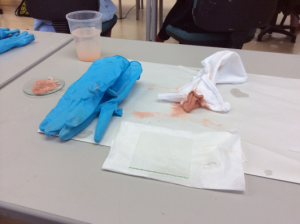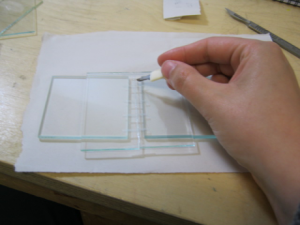“A picture is worth a thousand words”. As this often quoted adage alludes to, photographs have the ability to capture a moment in time. Whether they are images of stern Victorian family portraits or informal snaps of loved ones; spontaneous scenes of celebration or harrowing depictions of war and violence; shots of nature in all its glory or nature at its most powerful and destructive – photographs have the capacity to produce a wide spectrum of emotions in the viewer.
It is for such reasons that photographs form an invaluable part of the collections held by the University and why it is important that appropriate steps should be taken to ensure that they are preserved for future generations. I was fortunate, therefore, to have the opportunity to attend a three day course at West Dean College in Sussex on the ‘Conservation of Photographs’, led by photographic conservator Susie Clark.
During the course, I was introduced to the numerous photographic techniques and processes, which are many and varied. These range from daguerreotypes, developed by Louis Daguerre and introduced in 1839 – a date often cited as the ‘birth’ of photography – to glass plate slides, and right through to modern ink jet printing. What was clear from the outset of the course was that each process comes with its own associated conservation needs and, as a result, there is no “one size fits all” approach that can be taken when deciding on appropriate treatment options.
Damage to photographs can range from gradual deterioration due to natural ageing or poor storage and housing, to actual loss and breakage (to which glass slides, by their nature, are particularly susceptible). It was beneficial, therefore, that part of the course was dedicated to interventive ‘practical’ treatment options that could be carried out, with particular reference to the more vulnerable glass plate slides. This included polishing replacement cover glass (a rather messy process), which is in important step to ensure that any glass that is to come into contact with the photographic emulsion layer is completely clean and free of dirt and residue. We also had the opportunity to undertake different methods of repairing cracked or broken glass slides using various adhesives.
However, when it comes to caring for photographic collections, preventive measures are a far more favourable approach. Adopting correct storage, housing and environmental conditions (as discussed in our previous conservation blog post) can slow down the rate of deterioration, and ultimately reduce the need for more interventive conservation treatment further down the line. These measures can be particularly important when dealing with the more volatile photographic materials such cellulose acetate film. Upon degrading, this film material can suffer from the aptly named ‘Vinegar Syndrome’ due to its propensity to release acetic acid resulting in a distinctively strong odour.
Photographic techniques, for example tintypes (produced by creating a positive image on a sheet of iron), were often inexpensive and easy to produce. They were therefore in popular use at recreational destinations such beaches, promenades and parks, and were often taken on the spur of the moment to mark the day or capture a cherished event. Such photographs were not necessarily intended for longevity, and yet many now form an important part of our shared cultural collections.
This may make you look at your own collection of holiday snaps in a different way!


